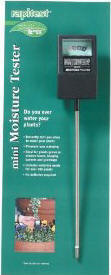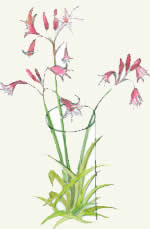Staking:
Dahlias and gladioli have heavy blooms and tall stalks and may need to be supported in order to stand straight during their blooming season. You can place stakes (Figure 1) in the proper position at the time of planting, this avoids possibly damaging the bulbs or tubers by driving in stakes after the bulb has been buried beneath the soil.

Figure 1 - Plant stakes
Another method that works quite well is the use of a support ring, as shown in Figure 2a.

Figure 2a - Soil moisture tester
Mulching:
For fall plantings of the larger bulbs, it is recommended that the planting bed be covered with two to three inches of mulch (Figure 3).
The use of mulch over the bed will help to control temperature changes and keep moisture from evaporating prematurely. Planting beds of small bulbs that bloom in very early spring should not be mulched.
Digging and Storing Spring Bulbs:
The dormant period for spring bulbs is the summer. Spring bulbs go dormant in late spring and early summer when the foliage dies. At the same time as the foliage dies, the roots are also dying. Fall weather, will bring the bulbs out of their dormant stage and the root systems will commence growing bringing nutrients and moisture back to the bulbs.

Figure 2 - Plant support ring

Figure 3 - Garden mulch
The time to dig up bulbs is when they are in their dormant stage. By digging the bulbs up you can divide them and spread them out evenly across the bed when replanting.
Bulbs that have been dug up must be stored in a well ventilated location and replanted in the fall. If you do not dig up your bulbs every year, daffodils and crocus should be dug up at least every five years so that they can be thinned out. If you do not thin these plants out you will end up with uneven plant height, a smaller flower size and uneven blooms.
Use a garden spading fork (Figure 4) to dig up summer flowering bulbs when the leaves have turned yellow. Bulbs should have all the soil washed off them and be dried with paper towel. This is not necessary if you are storing bulbs in pots with soil.

Figure 4 - Garden spading fork
Some bulbs do much better if the soil is left around the bulb; achimenes, begonia, canna, caladium, dahlia and ismene are in that group. The best method to store the aforementioned bulbs is in clumps on slightly moist sawdust or peat moss in a cool location. If you store your bulbs in this manner, prior to planting separate and wash the bulbs.
Bulbs that are washed should be dried and then stored in a shaded dry location, keep away from sunlight.
In most cases, bulbs should not be stored in areas where temperatures drop below 50 degrees or rise above 70 degrees Fahrenheit. The best temperature range is 60 to 65 degrees.
Before storing your bulbs, they should be inspected for disease and insect problems.Bulbs that are unusually small, soft or do not look healthy should be discarded.
It is important that air circulates freely around the bulbs in storage. Placing your bulbs on wire screens, only two layers deep will prevent heat buildup that will lead to bulb decay.
When in doubt visit your local nursery and ask an expert – this is not the time to speak to a part-time worker at your local big box retailer.
Additional information on Planting Bulbs
Part 1 – Soil Preparation, Fertilizing;
Part 2 – Planting Location, Planting Depth;
Part 3 – Watering, Removing Foliage;
